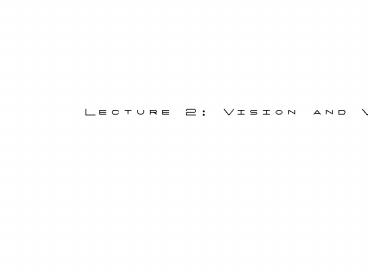Lecture 2: Vision and Visual Pathways - PowerPoint PPT Presentation
1 / 54
Title: Lecture 2: Vision and Visual Pathways
1
Lecture 2 Vision and Visual Pathways
2
(No Transcript)
3
(No Transcript)
4
(No Transcript)
5
(No Transcript)
6
(No Transcript)
7
(No Transcript)
8
(No Transcript)
9
(No Transcript)
10
(No Transcript)
11
(No Transcript)
12
(No Transcript)
13
(No Transcript)
14
(No Transcript)
15
Eye Cornea Pupil Lens retina Photoreceptors fov
ea (macula) optic disk
16
(No Transcript)
17
(No Transcript)
18
(No Transcript)
19
(No Transcript)
20
AMD
RP
21
From eye to V1 (geniculo-striate pathway) Optic
nerve Optic Chiasm Lateral Geniculate Nucleus
(LGN) Primary Visual Cortex (V1)
22
(No Transcript)
23
(No Transcript)
24
(No Transcript)
25
(No Transcript)
26
(No Transcript)
27
(No Transcript)
28
(No Transcript)
29
Vision loss from damage occurring at different
stages
30
(No Transcript)
31
(No Transcript)
32
(No Transcript)
33
Ocular dominance columns
34
(No Transcript)
35
(No Transcript)
36
Magno
Parvo
37
Two Pathways What vs. Where (Ungerleider and
Mishkin) Perception vs. Action or What vs. How
(Goodale and Milner)
38
action
What vs. where
perception
V1
Ungerleider and Mishkin, 1982
39
(No Transcript)
40
Haxby et al, 1994
Milner Goodale, 1993
41
Object-sensitive regions in human
brain (statistical map on inflated cortical
surface)
42
(No Transcript)
43
(No Transcript)
44
(No Transcript)
45
(No Transcript)
46
(No Transcript)
47
(No Transcript)
48
(No Transcript)
49
(No Transcript)
50
(No Transcript)
51
(No Transcript)
52
(No Transcript)
53
(No Transcript)
54
interesting numbers The eyes are 6 cm apart and
half-way down the head Visual angle of the sun
or moon 0.5 deg At arm's length thumbnail
1.5 deg thumb joint 2.0 deg fist 8-10 deg
Monocular visual field measured from central
fixation 160 deg (w) x 175 deg (h) Binocular
visual field measured from central fixation 200
deg (w) x 135 deg (h) Retinal size 5 cm x 5
cm 0.4 mm thick Size of each area V1 3cm by 8
cm Half of area V1 represents the central 10
deg (2 of the visual field) Highest detectable
spatial frequency at high ambient light levels,
50-60 cpd low ambient light levels, 20-30 cpd
Highest detectable temporal frequency high
ambient large field, 80 Hz low ambient, large
field 40 Hz. Visible spectrum 370-730 nm.































